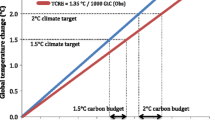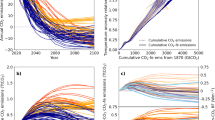Abstract
Emissions may affect climate indirectly through chemical interactions in the atmosphere, but quantifications of such effects are difficult and uncertain due to incomplete knowledge and inadequate methods. A preliminary assessment of the climatic impact of changes in tropospheric O3 and CH4 in response to various emissions is given. For a 10% increase in the CH4 emissions the relative increase in concentration has been estimated to be 37% larger. The radiative forcing from enhanced levels of tropospheric O3 is estimated to 37% of the forcing from changes in CH4. Inclusion of indirect effects approximately doubles the climatic impact of CH4 emissions. Emissions of NOx increase tropospheric O3, while the levels of CH4 are reduced. For emissions of NOx from aircraft, the positive effects via O3 changes are significantly larger than the negative through changes in CH4. For NOx emitted from surface sources, the effects through changes in O3 and CH4 are estimated to be of similar magnitude and large uncertainty is connected to the sign of the net effect. Emissions of CO have positive indirect effects on climate through enhanced levels of tropospheric o3 and increased lifetime of CH4. These results form the basis for estimates of global warming potentials for sustained step increases in emissions.
Similar content being viewed by others
References
Arnold, F., Scheid, J., Stilp, Th., Schlager, H., and Reinhardt, M.E.: 1992, ‘Measurements of Jet Aircraft Emissions at Cruise Altitude I: The Odd-Nitrogen Gases NO, NO2, HNO2 and HNO3’, Geophys. Res. Lett. 12, 2421–2424.
Berntsen, T., Solberg, S., and Isaksen, I. S. A.: 1989, ‘Calculated Changes in the Tropospheric Distribution of Long-Lived Primary Trace Species and in Secondary Species Resulting from Releases of Pollutants’, Report No. 74, Institute for Geophysics, University of Oslo.
Berntsen, T., and Isaksen, I. S. A.: 1994, ‘A 3-D Photochemistry/Transport Model of the Global Troposphere’, Institute Report No. 89, Department of Geophysics, University of Oslo.
Derwent, R.: 1994, ‘The Estimation of Global Warming Potentials for a Range of Radiatively Active Gases’, in Ham, J. van, Janssen, L. J. H. M., and Swart, R. J. (eds.), Non-CO 2 Greenhouse Gases: Why and How to Control?, Kluwer, Dordrecht, pp. 289–299.
Fisher, D. A., Hales, C. H., Wang, W.-C., Ko, M. K. W, and Sze, N. D.: 1990, ‘Model Calculations of the Relative of CFCs and their Replacements on Global Warming’, Nature 344, 513–516.
Fuglestvedt, J. S., Berntsen, T. K., and Isaksen, I. S. A.: 1993, ‘Response in Tropospheric O3, OH and CH4 to Changed Emissions of Important Trace Gases’, Report 1993:4, CICERO, University of Oslo.
Fuglestvedt, J. S., Jonson, J. E., and Isaksen, I. S. A.: 1994, ‘Effects of Reductions in Stratospheric Ozone on Tropospheric Chemistry through Changes in Photolysis Rates’, Tellus 46B, 172–192.
Fuglestvedt, J. S.: 1995, ‘Model Studies of Indirect Effects on Climate through Changes in the Chemistry of the Troposphere’, Ph.D. Thesis, April 1995, Department of Chemistry, University of Oslo, Norway.
Fuglestvedt, J. S., Jonson, J. E., Isaksen, I. S. A., and Wang, W.-C.: 1995, ‘Responses in Tropospheric Chemistry to Changes in UV Fluxes, Temperatures and Water Vapour Densities’, in Wang, W.-C. and Isaksen, I. S. A. (eds.), Atmospheric Ozone as a Climate Gas, NATO ASI series, Springer, Heidelberg.
Hauglustaine, D. A., Granier, C., Brasseur, G. P., and Megie, G.: 1994a, ‘The Importance of Atmospheric Chemistry in the Calculation of Radiative Forcing of the Climate System’, J. Geophys. Res. 99, 1173–1186.
Hauglustaine, D. A., Granier, C., and Brasseur, G. P.: 1994b, ‘Impact of Increased Methane Emissions on the Atmospheric Composition and Related Radiative Forcing on the Climate System’, in Ham, J. van, Janssen, L. J. H. M., and Swart, R. J. (eds.), Non-CO 2 Greenhouse Gases: Why and How to Control?, Kluwer, Dordrecht, pp. 253–259.
Hauglustaine, D. A., Granier, C., Brasseur, G. P., and Mégie, G.: 1994c, ‘Impact of Present Aircraft Emissions of Nitrogen Oxides on Tropospheric Ozone and Climate Forcing’, Geophys. Res. Lett. 21, 2031–2034.
Isaksen, I. S. A., Hesstvedt, E., and Hov, Ø.: 1978a, ‘A Chemical Model for Urban Plumes: Test for Ozone and Particulate Sulfur Formation in St. Louis Urban Plume’, Atmos. Environ. 12, 599–604.
Isaksen, I. S. A., Hov, Ø., and Hesstvedt, E.: 1978b, ‘Ozone Generation over Rural Areas’, Environ. Sci. Tech. 12, 1279–1284.
Isaksen, I. S. A.: 1980, ‘The Tropospheric Ozone Budget and Possible Man-Made Effects’, in London, J. (ed.), Proc. Quadrennial Int. Ozone Symp., Vol. II, International Ozone Commission, Boulder, CO, Aug. 1980, pp. 845–852.
Isaksen, I. S. A. and Hov, Ø.: 1987, ‘Calculations of Trends in the Tropospheric Concentrations of O3, OH, CO, CH4, and NOx’, Tellus 39B, 271–283.
Isaksen, I. S. A., Rognerud, B., Stordal, F., Coffey, M. T., and Mankin, W. G.: 1990, ‘Studies of Arctic Stratospheric Ozone in a 2-D Model Including Some Effects of Zonal Asymmetries’, Geophys. Res. Lett. 17, 557–560.
Isaksen, I. S. A., Lee, Y.-P., Atkinson, R., Sidebottom, H., Fuglestvedt, J. S., Johnson, C., Lelieveld, J., and Thompson, A.: 1992, Chapter 5: ‘Tropospheric Processes: Observations and Interpretation’, in: Scientific Assessment of Ozone Depletion: 1991, World Meteorological Organization, Global Ozone Research and Monitoring Project, Report No. 25,1992.
IPCC: 1990, Climate Change: The Scientific Assessment, Houghton, J. T. G. J., and Ephraums, J. J. (eds.), Cambridge University Press, Cambridge, U.K.
IPCC: 1992, Climate Change: The Supplementary Report to the IPCC Scientific Assessment, Houghton, J. T., Callander, B. A., and Varney, S. K. (eds.), Cambridge University Press, Cambridge, U. K.
IPCC: 1994, Climate Change, Reports of the Working Groups I and III of the Intergovernmental Panel on Climate Change, Houghton, J. T., Meira Filho, L. G., Bruce, J., Hoesung, Lee, Callander, B. A., Haites, E., Harris, N., and Maskell, K. (eds.), Cambridge University Press, Cambridge, U.K.
Jacob, D. J.: 1986, ‘Chemistry of OH in Remote Clouds and its Role in the Production of Formic Acid and Peroxymonosulfate’, J. Geophys. Res. 91, 9807–9826.
Johnson, C., Henshaw, J., and Mclnnes, G.: 1992, ‘Impact of Aircraft and Surface Emissions of Nitrogen Oxides on Tropospheric Ozone and Global Warming’, Nature 355, 69–71.
Johnson, C. J.: 1994, ‘Global Warming from Aircraft NOx Emissions’, in Schumann, U., and Wurzel, D. (eds.), Impact of Emissions from Aircraft and Spacecraft upon the Atmosphere, Proc. Int. Sci. Colloquium, Cologne, Germany, April 18–20, 1994.
Jonson, J. E. and Isaksen, I. S. A.: 1993, ‘Tropospheric Ozone Chemistry, The Impact of Cloud Chemistry’, J. Atmos. Chem. 16, 99–122.
Jonson, J. E., and Isaksen, I. S. A.: 1994, ‘The Sensitivity of Tropospheric Chemistry to Cloud Interactions’, in Huson, R. D. (ed.), Proc. 5th Quadrennial Ozone Symp., NASA Conf. Publ. 3266, pp. 99–122.
Kanakidou, M. and Crutzen, P. J.: 1992, ‘Scale Problems in Global Tropospheric Chemistry Modelling: Comparison of Results Obtained with a Three-Dimensional Model, Adopting Longitudinally Uniform and Varying Emissions of NOx and NMHC’, Chemosphere 26, 798–801.
Lacis, A. A., Wuebbles, D. J., and Logan, J. A.: 1990, ‘Radiative Forcing of Climate by Changes in the Vertical Distribution of Ozone’, J. Geophys. Res. 95, D7, 9971–9981.
Lelieveld, J., Crutzen, P. J., and Rodhe, H.: 1989, ‘Zonal Average Cloud Characteristics for Global Atmospheric Chemistry Modelling’, GLOMAC-report UDC 551.510.4, CM 76, Int. Meteorological Institute in Stockholm.
Lelieveld, J. and Crutzen, P. J.: 1990, ‘Influences of Cloud Photochemical Processes on Tropospheric Ozone’, Nature 343, 227–233.
Lelieveld, J. and Crutzen, P. J.: 1991, ‘The Role of Clouds in Tropospheric Photochemistry’, J. Atmos. Chem. 12, 229–267.
Lelieveld, J. and Crutzen, P. J.: 1992, ‘Indirect Chemical Effects of Methane on Climate Warming’, Nature 355, 339–342.
Lelieveld, J., Crutzen, P. J., and Brühl, C.: 1993, ‘Climate Effects of Atmospheric Methane’, Chemosphere 26, 739–768.
Lelieveld, J. and Crutzen, P. J.: 1994, ‘Role of Deep Cloud Convection in the Ozone Budget of the Troposphere’, Science 264, 1759–1761.
Lelieveld, J. and van Dorland, R.: 1995, ‘Ozone Chemistry Changes in the Troposphere and Consequent Radiative Forcing of Climate’, in Wang, W.-C. and Isaksen, I. S. A. (eds.), Atmospheric Ozone as a Climate Gas, NATO ASI Series, Springer, Heidelberg.
Lin, X., Trainer, M., and Liu, S. C.: 1988, ‘On the Nonlinearity of the Tropospheric Ozone Production’, J. Geophys. Res. 93, 15879–15888.
Liu, S. C., Trainer, M., Fehsenfeld, F. C., Parrish, D. D., Williams, E. J., Fahey, D. W., Hübler, G., and Murphy, P. C.: 1987, ‘Ozone Production in the Rural Troposphere and the Implications for Regional and Global Ozone Distributions’, J. Geophys. Res. 92, 4191–4207.
Prather, M. J.: 1994, ‘Lifetimes and Eigenstates in Atmospheric Chemistry’, Geophys. Res. Lett. 21, 801–804.
Rind, D. and Lacis, A.: 1993, ‘The Role of the Stratosphere in Climate Change’, Surveys in Geophysics 14, 133–165.
Thompson, A. M. and Stewart, R. W.: 1991, ‘Effect of Chemical Kinetics Uncertainties on Calculated Constituents in a Tropospheric Photochemical Model’, J. Geophys. Res. 96, 13089–13108.
Wang, W.-C., Pinto, J. P., and Yung, Y. L.: 1980, ‘Climatic Effects Due to Halogenated Compounds in the Earth's Atmosphere’, J. Atmos. Sci. 37, 333–338.
Wang, W.-C., and Molnar, G.: 1985, ‘A Model Study of the Greenhouse Effects Due to Increasing Atmospheric CH4, N2O, CF2C12, and CFCl3’, J. Geophys. Res. 90, 12971–12980.
Wang, W.-C., Dudek, M. P., and Liang, X.-Z.: 1992, ‘Inadequacy of Effective CO2 as a Proxy in Assessing the Regional Climate Change Due to Other Radiatively Active Gases’, Geophys. Res. Lett. 19, 1375–1378.
Wigley, T. M. and Reeves, C.: 1991, Global Warming Potentials, A report to the U.K. Department of the Environment and the Hadley Centre for Climate Prediction and Research.
Wigley, T. M. L. and Osborn, T. J.: 1994, ‘Indirect Global Warming Potentials for Methane Due to OH Feedback’, Geophys. Res. Lett., in press.
WMO: 1986, Atmospheric Ozone 1985, Assessment of our Understanding of the Processes Controlling its Present Distribution and Change, Vol. I, WMO Global Ozone Research and Monitoring Project, Report No. 16.
WMO: 1992, Scientific Assessment of Ozone Depletion: 1991, WMO/UNEP, WMO Global Ozone Research and Monitoring Project, Report No. 25.
World Meteorological Organization (WMO): 1995, Scientific Assessment of Ozone Depletion: 1994, WMO/UNEP, WMO Global Ozone Research and Monitoring Project, Report No. 37.
Wuebbles, D. J., Grant, K. E., Connell, P. S., and Penner, J. E.: 1989, ‘The Role of Atmospheric Chemistry in Climate Change’, JAPCA 39, 1, 22–28.
Wuebbles, D. J. and Tameresis, J. S.: 1993, ‘The Role of Methane in the Global Environment’, in Khalil, M. A. K. (ed.), Atmospheric Methane: Sources, Sinks, and Role in Global Change, NATO ASI Series, Vol. I, Springer, Berlin, p. 13.
Author information
Authors and Affiliations
Rights and permissions
About this article
Cite this article
Fuglestvedt, J.S., Isaksen, I.S.A. & Wang, WC. Estimates of indirect global warming potentials for CH4, CO and NOX . Climatic Change 34, 405–437 (1996). https://doi.org/10.1007/BF00139300
Received:
Revised:
Issue Date:
DOI: https://doi.org/10.1007/BF00139300




